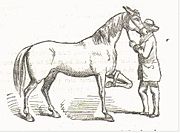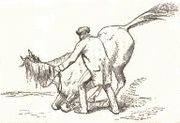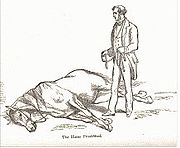
Rarey technique
Encyclopedia

Horse
The horse is one of two extant subspecies of Equus ferus, or the wild horse. It is a single-hooved mammal belonging to the taxonomic family Equidae. The horse has evolved over the past 45 to 55 million years from a small multi-toed creature into the large, single-toed animal of today...
s that have become vicious and fearful of humans due to abusive handling or other traumatic events. It is named for its inventor, John Solomon Rarey
John Solomon Rarey
John Solomon Rarey was one of the nineteenth century horse whisperers, an important figure in the rehabilitation of abused and vicious horses during the 1850s. Originally from Groveport, Ohio, Rarey trained his first horse at the age of twelve...
(1827–1866) of Groveport, Ohio
Groveport, Ohio
Groveport is a City in Franklin County, Ohio, United States. The population was 5,363 at the 2010 census.Groveport was the hometown of John Solomon Rarey, a 19th century horse whisperer, and developer of the Rarey technique for rehabilitating horses...
, USA, who became famous for taming violent horses with it, and later for teaching it in various countries around the world.
The word rareyfy, meaning "to win by love" or "to tame a horse by kindness", entered the English language
English language
English is a West Germanic language that arose in the Anglo-Saxon kingdoms of England and spread into what was to become south-east Scotland under the influence of the Anglian medieval kingdom of Northumbria...
because of this technique (although it is no longer in common usage in this sense today). The technique is also depicted in the book and movie The Horse Whisperer
The Horse Whisperer
The Horse Whisperer is a 1998 American drama film directed by and starring Robert Redford, based on the 1995 novel of the same name by Nicholas Evans...
, whose main character is modeled after Rarey.
The technique



Rarey's method was remarkable because:
- it could be used even by trainers who lacked physical strength.
- it was a peaceful method of taming, which contrasted with the common opinion at the time that a vicious horse must be "broken" by force and violence.
- horses so tamed could be handled by anyone, not only the trainer.
Psychology
A wild or feralFeral
A feral organism is one that has changed from being domesticated to being wild or untamed. In the case of plants it is a movement from cultivated to uncultivated or controlled to volunteer. The introduction of feral animals or plants to their non-native regions, like any introduced species, may...
horse may be wary of human beings, but it will not be prejudiced against them, and horses can very quickly learn that humans can be welcome associates of theirs. On the other hand, if a human repeatedly attacks a horse for no good reason, then the horse can begin to treat humans as enemies. Though they are not predators, horses are well adapted to protecting themselves with both front and rear hooves, and with their teeth. In addition, when a horse rejects its rider by rearing up on its hind legs, the rider could be seriously injured, or even killed if the horse falls over and lands on him. Therefore, vicious horses are no longer safe companions for human beings, and unless they can be rehabilitated somehow, they may end up being destroyed.
It is very difficult to modify the behavior of animals that have learned that their well-being depends on performing preventative measures. If, for example, a rat or other laboratory animal is placed in a cage constructed in such a way that it can be shocked no matter where it stands, and if a shock is delivered on a timed basis unless the animal presses a lever before the shock is scheduled to be delivered, then the rat will very readily learn to press the lever. It will treat the regular manipulation of the lever as a matter of life and death. It will be so faithful in its endeavors to press the lever, in fact, that the shock mechanism can be disconnected without any change occurring in the rat's behavior for a very long time. The reason is that the rat never dares to test what might happen should the lever not get pressed.
Similarly, the abused horse learns the lesson that it must protect itself against human beings, because the human beings it has had to deal with in the past have caused it terror and pain. So, just as the rat protects itself by continually pressing the lever, the horse continues in its efforts to drive human beings off and thwart their hurtful behavior. It will not try to learn what might happen if it did nothing to drive humans away. To refrain from thwarting human beings means, to the abused horse, giving humans the opportunity to hurt or even to kill it.
What Rarey did was the behavioral equivalent of preventing the rat from pushing the lever so that the rat could discover that it no longer mattered whether it pushed the lever or not. For the horse, that means to be put in a situation in which it is absolutely unable to do anything to thwart human contact, so that it can learn that even though it is totally unable to protect itself, it will not be hurt in any way.
Rarey's method is susceptible to being misunderstood, because it would superficially appear to be a demonstration of how a human can dominate a horse, when in fact the demonstration is that regardless of any capacity to do harm the human is in fact making no such attempt. Some may wonder whether this lesson is a good one for the horse to learn, since the abusive human may return. However, horses are known to have extremely good memories, and would most likely remember a hurtful human being, as well as remember the most effective ways it had found to fight back against that abusive individual.
See also
- The Modern Art of Taming Wild Horses, the booklet of Rarey hosted into wikisource
- Horse breaking
- Horseman's WordHorseman's WordThe Society of the Horseman's Word was a fraternal secret society that operated in Scotland from the eighteenth through to the twentieth century. Its members were drawn from those who worked with horses, including horse trainers, blacksmiths and ploughmen, and involved the teaching of magical...
External links
- Rarey's extended description of his method of rehabilitating abused horses is given in full on the web site created and maintained by some of his descendants, The Original Horse Whisperer

